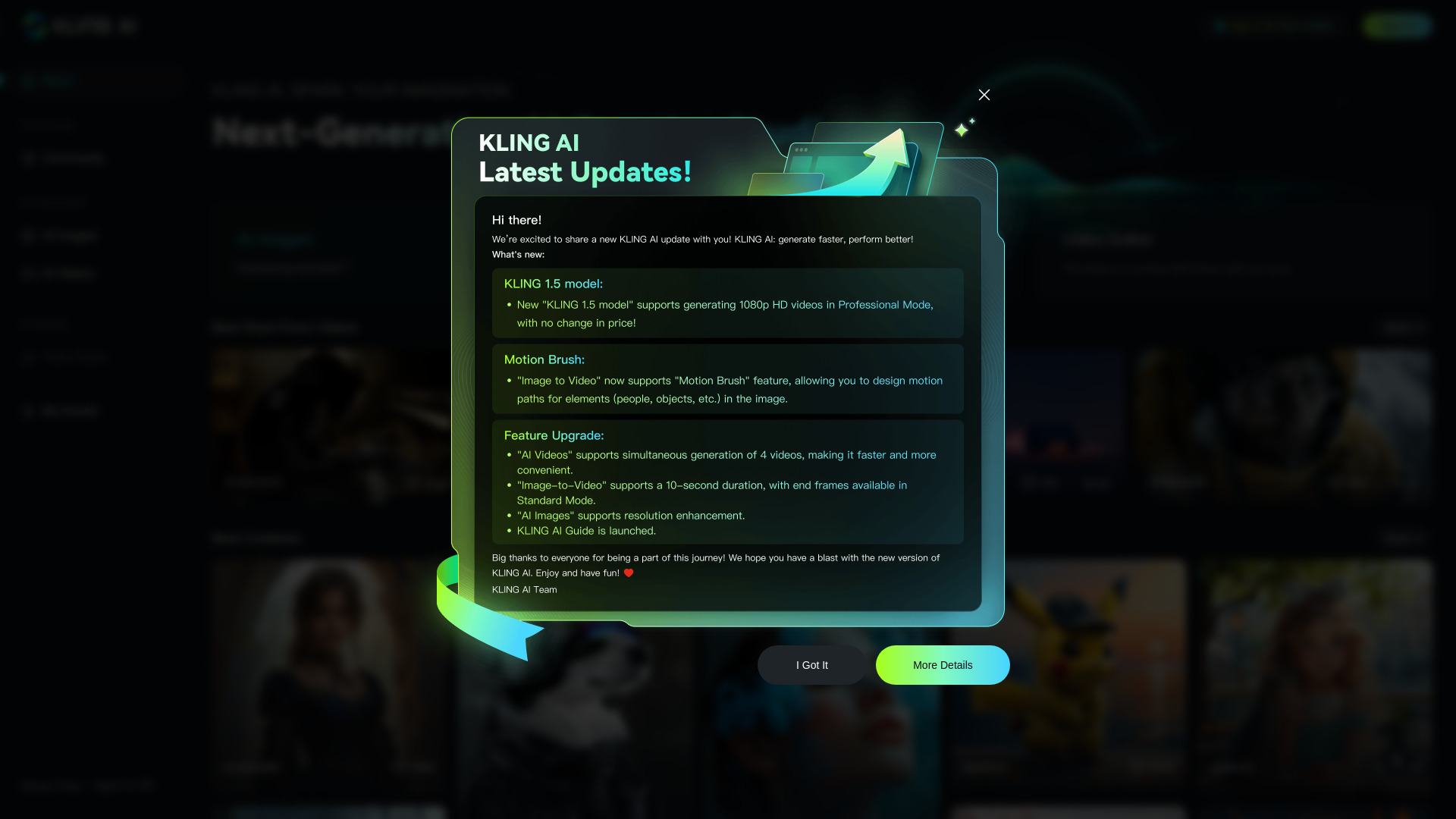- Home
- AI Image Generator
- Kling AI

Kling AI
Open Website-
Tool Introduction:All-in-one AI studio for image/video creation, script-to-screen + APIs
-
Inclusion Date:Oct 21, 2025
-
Social Media & Email:
Tool Information
What is Kling AI
Kling AI is a next-generation creative studio powered by state-of-the-art generative AI. It helps teams turn ideas into production-ready images and videos through a unified workflow that spans scriptwriting, storyboarding, scene design, and final rendering. With text-to-video, text-to-image, and smart scene capabilities, Kling AI streamlines concepting, iteration, and delivery. Its developer platform includes video and image generation APIs, plus smart scene APIs, enabling product teams to embed high-quality creation directly into apps and pipelines.
Kling AI Main Features
- End-to-end creation pipeline: Move seamlessly from script to storyboard to final video without switching tools, reducing handoffs and friction.
- Text-to-video and text-to-image: Generate cinematic sequences and high-fidelity images from prompts, references, or structured inputs.
- Smart scene capabilities: Use scene-aware generation to maintain continuity in characters, lighting, framing, and locations across cuts.
- Storyboard-first workflow: Block scenes, preview pacing, and iterate shot-by-shot before rendering, improving creative control.
- Style and brand consistency: Apply styles, palettes, and visual rules so outputs stay on-brand across campaigns and channels.
- API platform: Integrate video and image generation into products and pipelines with developer-friendly APIs and smart scene endpoints.
- Asset management and versioning: Organize prompts, scenes, takes, and outputs; compare versions to choose the best result.
- Scalable rendering: Generate at scale for multi-variant testing, localization, or bulk creative production.
Who Is Kling AI For
Kling AI suits marketers, social media teams, and creative agencies producing short-form video, ads, and campaign assets. It supports filmmakers and previsualization teams planning shots and storyboards. Product designers and game studios can concept worlds and characters rapidly. Educators and course creators can build explainers and lectures. Developers and platform teams can embed AI video generation and image generation via APIs to power user-facing creativity features.
How to Use Kling AI
- Create an account and choose a workspace for your project or team.
- Select a mode: text-to-video, text-to-image, or storyboard-driven production.
- Draft a script or prompt; add references (images, style notes, or timing cues) for guidance.
- Build a storyboard: define shots, camera angles, characters, and scene transitions.
- Use smart scene controls to maintain continuity for style, lighting, and subjects across shots.
- Generate previews, review results, and iterate by editing prompts, frames, or shot timing.
- Render final outputs at the desired quality and aspect ratio.
- Export assets or deploy via the developer APIs into your app or workflow.
Kling AI Industry Use Cases
Brands and agencies produce social ads and product videos at scale, testing multiple creative variants. E-commerce teams generate lifestyle imagery and 360° product visuals without expensive shoots. Media and entertainment studios use storyboard-to-video for previsualization and mood reels. EdTech providers create explainer animations and lecture snippets from scripts. App developers integrate text-to-video features so users can turn prompts into shareable content inside their platforms.
Kling AI Pricing
Pricing and plan details can change over time and may differ for studio access versus API usage. For the most accurate information on tiers, usage limits, and any free trials or credits, please refer to the official Kling AI product pages.
Kling AI Pros and Cons
Pros:
- Unified script-to-storyboard-to-video workflow reduces tool switching and production time.
- Smart scene capabilities improve continuity across shots and scenes.
- Developer-ready APIs enable seamless integration of generative video and image features.
- Efficient iteration allows rapid experimentation and multi-variant creative testing.
- Supports consistent brand styling across campaigns and channels.
Cons:
- Learning curve for prompt design, storyboarding, and scene controls.
- Output quality and coherence depend on prompt clarity and reference assets.
- Render times and costs can increase with higher resolutions or long sequences.
- Compliance, rights management, and data governance require careful review for commercial use.
Kling AI FAQs
-
What makes Kling AI different from other AI video tools?
It emphasizes an end-to-end pipeline with storyboard-first control and smart scene continuity, plus a developer platform for API-based integration.
-
Does Kling AI support APIs for video and image generation?
Yes. The developer platform provides video and image generation APIs along with smart scene APIs for embedding creation in products.
-
Can I maintain a consistent style across multiple outputs?
Yes. Style settings and scene-aware controls help keep characters, palettes, and lighting consistent across shots and campaigns.
-
Is Kling AI suitable for large-scale production?
Its workflow, versioning, and scalable rendering support bulk generation, localization, and multi-variant testing.
-
Can I use the generated content commercially?
Commercial use depends on the platform’s terms and applicable laws. Review licensing, rights, and data policies for your plan and region.



